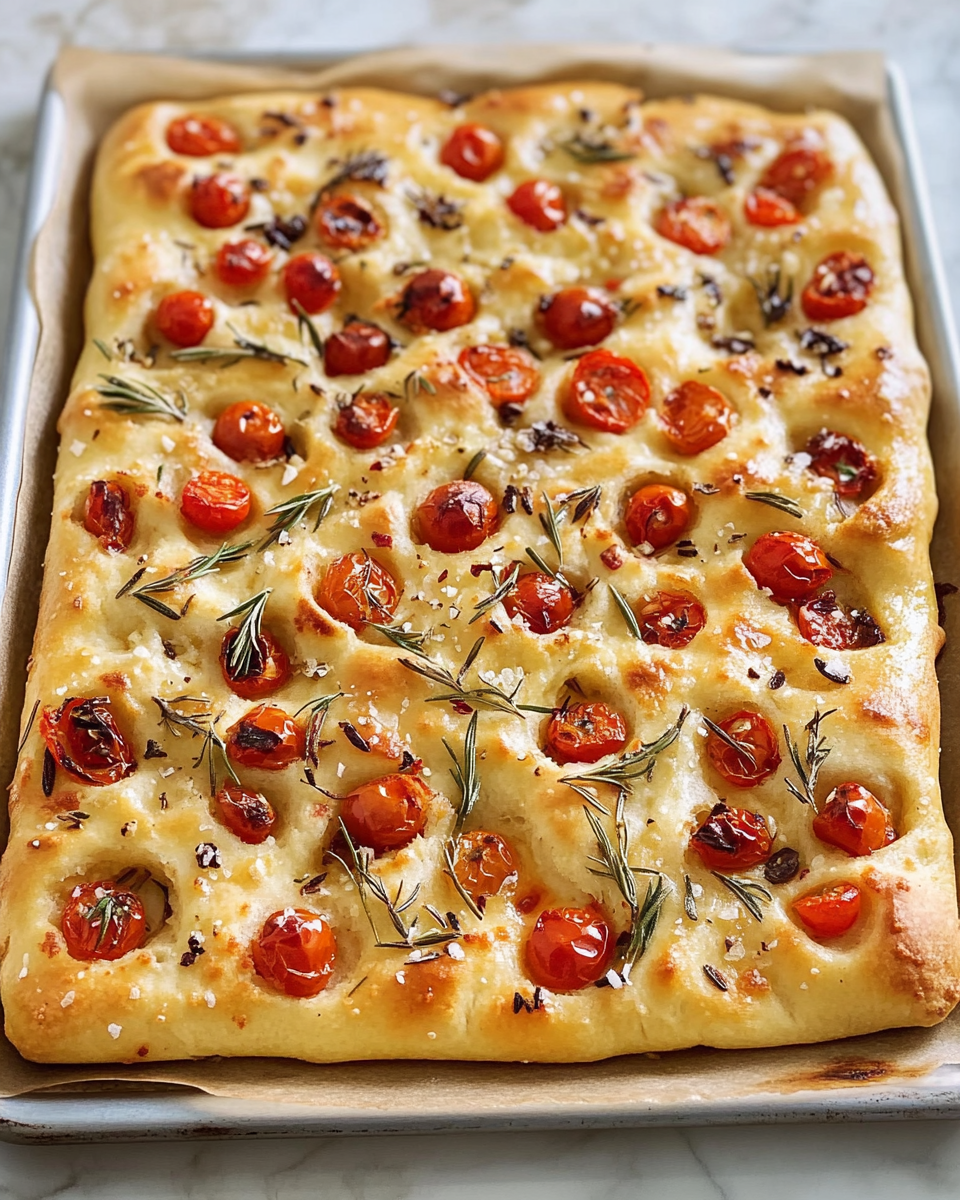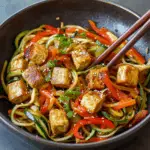A golden, crispy-edged bread infused with olive oil, fresh herbs, and bursts of juicy tomatoes, this rustic focaccia is the perfect balance of chewy and airy. Ideal as a side, appetizer, or base for sandwiches, it brings Mediterranean flavor to any table.
FULL RECIPE
Ingredients
- 4 cups all-purpose flour
- 1 tablespoon sugar
- 2 teaspoons kosher salt
- 1 packet (2¼ teaspoons) active dry yeast
- 1½ cups warm water (about 110°F)
- ¼ cup extra-virgin olive oil, plus more for drizzling
- 1 pint cherry tomatoes, halved
- 1 tablespoon chopped fresh rosemary
- 1 tablespoon chopped fresh thyme
- Coarse sea salt, for sprinkling
Directions
- In a large bowl, combine flour, sugar, and kosher salt.
- In a separate bowl, mix warm water and yeast. Let sit for 5–10 minutes until foamy.
- Add the yeast mixture and olive oil to the flour mixture. Stir until a sticky dough forms.
- Transfer the dough to a lightly oiled bowl, cover, and let rise in a warm place for 1–1½ hours until doubled in size.
- Line a baking sheet with parchment paper and drizzle with olive oil.
- Gently press the risen dough into the prepared pan. Cover and let rise again for 20–30 minutes.
- Preheat oven to 425°F (220°C).
- Dimple the surface of the dough with your fingers. Scatter tomato halves over the top, cut side up.
- Sprinkle with rosemary, thyme, and coarse sea salt. Drizzle generously with olive oil.
- Bake for 25–30 minutes or until golden brown and crisp on the edges.
- Cool slightly before slicing and serving.
Nutritional Information
- Calories: 210 per serving (based on 12 servings)
- Fat: 8g
- Carbohydrates: 30g
- Protein: 4g
- Fiber: 1g
- Sodium: 300mg
History of Focaccia
Focaccia is a traditional Italian flatbread with roots dating back thousands of years. It originated in Ancient Rome and was considered a simple, hearty bread made by Roman bakers. Over time, focaccia evolved into regional variations across Italy, each bringing unique flavors and toppings such as olives, herbs, and tomatoes. This bread’s rustic character reflects the Mediterranean lifestyle, where fresh, local ingredients are central.
The Role of Olive Oil
Olive oil is essential to focaccia’s flavor and texture. It enriches the dough, making it tender and moist, while also creating the crispy, golden crust on the outside. The generous drizzle of extra-virgin olive oil before baking adds a fruity, peppery note that complements the herbs and tomatoes beautifully. High-quality olive oil is preferred for the best aroma and taste.
Choosing the Right Flour
Using all-purpose flour is common for rustic focaccia, but some bakers opt for bread flour to achieve a chewier texture. Bread flour’s higher protein content helps develop gluten, which creates the desired airy crumb and elasticity. Sifting flour properly and measuring accurately also contribute to the bread’s consistency.
Yeast and Fermentation
Active dry yeast is the leavening agent that gives focaccia its lightness. The fermentation process, where the dough rises and develops flavor, is crucial. A slow, cool rise enhances the bread’s taste by allowing natural sugars to develop and strengthens the gluten network. Some recipes call for overnight fermentation in the refrigerator for a deeper flavor.
Water Temperature Importance
The water used to activate the yeast should be warm but not hot, ideally around 110°F (43°C). Too hot water can kill the yeast, while cold water slows the activation. The correct temperature ensures the yeast produces carbon dioxide efficiently, causing the dough to rise properly and creating a light, airy texture.
The Dough’s Hydration Level
Focaccia dough is wetter and stickier compared to regular bread dough. The higher hydration level helps create large, irregular holes inside the bread, giving it an open crumb structure. This moisture also contributes to the soft, pillowy inside contrasted with the crispy crust outside.
Resting and Rising Times
Proper resting and rising times are fundamental for focaccia’s texture. After mixing, the dough needs to rise until doubled in size, usually about one to one and a half hours. A second shorter rise after shaping allows the dough to relax and puff up, which helps the bread stay light rather than dense.
Shaping the Dough
Unlike more formal bread, focaccia’s shaping is informal and rustic. The dough is gently pressed out into a pan without deflating it completely. Finger dimpling the surface is a signature technique that helps trap olive oil and toppings, and also prevents the dough from puffing up too much in the oven.
The Importance of Toppings
Toppings not only add flavor but also texture and visual appeal. Cherry tomatoes provide bursts of juicy sweetness that contrast with the savory herbs. Fresh rosemary and thyme add aromatic, piney notes. Coarse sea salt sprinkled on top enhances all the flavors and creates a slight crunch.
Baking Techniques
Baking focaccia at a relatively high temperature (around 425°F or 220°C) helps develop a crunchy, golden crust while keeping the interior soft. Using a well-oiled baking pan prevents sticking and promotes browning on the bottom. Some bakers add steam in the oven for extra crust crispiness.
Serving Suggestions
Focaccia is incredibly versatile. It can be served warm as an appetizer dipped in olive oil or balsamic vinegar, used as sandwich bread, or alongside soups and salads. It also pairs wonderfully with cheeses, cured meats, or roasted vegetables for a Mediterranean-inspired meal.
Storage and Shelf Life
Fresh focaccia is best eaten within a day or two. To keep it fresh longer, wrap it tightly in plastic wrap or store it in an airtight container at room temperature. For extended storage, focaccia freezes well. Reheating in the oven helps restore its crispness and fresh-baked texture.
Variations and Add-Ins
Focaccia can be customized endlessly. Popular additions include olives, caramelized onions, garlic, sun-dried tomatoes, and different herbs. Some recipes incorporate cheese like Parmesan or mozzarella. Each variation brings a new flavor profile while maintaining the bread’s characteristic rustic charm.
Health Benefits of Ingredients
While focaccia is indulgent, it contains beneficial ingredients. Olive oil offers healthy monounsaturated fats and antioxidants. Fresh herbs contribute vitamins and minerals, and tomatoes provide lycopene, a powerful antioxidant. Moderation is key to enjoying focaccia as part of a balanced diet.
Common Mistakes to Avoid
Overworking the dough can result in a tough focaccia, so gentle handling is important. Not giving the dough enough time to rise leads to a dense texture. Using too little olive oil or skipping the dimpling can make the bread dry. Proper oven temperature is also critical to avoid underbaking or burning.
Focaccia in Modern Cuisine
Today, focaccia enjoys global popularity beyond Italy. It appears in gourmet sandwiches, trendy cafes, and fusion dishes. Chefs experiment with toppings and shapes, making focaccia a versatile canvas for culinary creativity. Its rustic simplicity combined with rich flavor keeps it a beloved bread worldwide.
Pairing with Wines and Beverages
Focaccia pairs excellently with Mediterranean wines like Chianti or Pinot Grigio. The herbaceous and slightly salty flavor of the bread complements crisp whites and light reds. For non-alcoholic options, herbal teas or sparkling water with lemon enhance the bread’s fresh, vibrant notes.
Gluten-Free and Alternative Versions
For those with gluten sensitivities, gluten-free focaccia recipes use alternative flours such as rice, almond, or chickpea flour. These versions require adjustments in hydration and rising times but aim to replicate the texture and flavor of traditional focaccia. Experimentation helps find the best blend for personal preference.
Focaccia’s Cultural Significance
In Italy, focaccia is more than bread; it’s a social food symbolizing hospitality and communal sharing. It is often enjoyed during gatherings, festivals, and family meals. Its simple ingredients reflect humble origins, yet its rich taste makes it a celebratory dish.
Environmental Impact of Ingredients
Using locally sourced, organic ingredients for focaccia reduces environmental footprint. Olive oil production has varying sustainability impacts depending on farming methods. Choosing fresh, seasonal tomatoes and herbs also supports local agriculture and reduces transportation emissions.
Conclusion
Rustic tomato herb focaccia is a timeless bread that embodies simplicity and flavor. Its roots in ancient culinary traditions combine with the freshness of Mediterranean ingredients to create a versatile, satisfying dish. Mastering focaccia baking brings joy and connection to heritage, while its adaptability invites endless creativity. Whether served warm from the oven or as part of a shared meal, focaccia remains a beloved staple that brings people together with every delicious bite.






